Share this page
Your guide to recently released books, CDs and other teaching resources.
For additional reviews of French-language resources, visit pourparlerprofession.oeeo.ca. With the exception of some classroom sets, items reviewed are available on loan from the Margaret Wilson Library at the College. Contact us at 416-961-8800 (toll-free in Ontario 1-888-534-2222), ext 679 or email library@oct.ca.
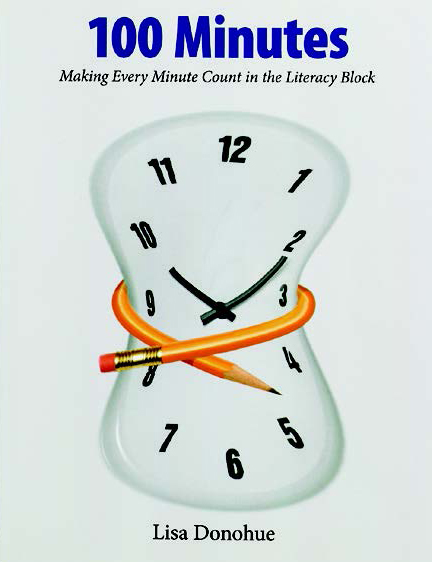
By Lisa Donahue
This decidedly useful resource explores literacy by integrating both traditional reading, writing and oral communication skills with digital literacy. Examined within the framework of three distinct blocks during a 100-minute time span, it combines whole-class instruction, writing sessions with small groups and independent work. The framework suggests that students learn, practise and apply their new skills gradually, becoming more and more independent as they do so. After direct instruction and modelling, followed by guided instruction, collaborative learning opportunities and conferencing, the idea is that students will work independently to apply their learning and integrate it into all other aspects of their other literacy experiences.
The book outlines the importance of creating literacy blocks in a classroom where students are treated as 21st- century learners who have a choice as well as a voice in their own learning. With cyberspace filled with endless possibilities for distraction, it can be a huge challenge to keep students focused on the nuts and bolts of a solid literacy foundation. Under these circumstances, it becomes imperative for students to own their own learning by capitalizing on their strengths and setting some personal learning goals for themselves. 100 Minutes is set up in such a way that a regular classroom teacher could start teaching such blocks directly from the text; a soup-to-nuts approach where the ideas are clearly explained and exemplified and all necessary templates are provided. Whether one is using literacy blocks, or considering using them in the future, I would highly recommend this book to teachers in both the elementary and secondary teaching panels.
Majella Atkinson, OCT, is a Grade 8 teacher at St. Pius X Catholic School in Toronto.
100 Minutes: Making Every Minute Count in the Literacy Block, Pembroke Publishers, Markham, 2012, softcover, ISBN 978-1-55138-276-0, 157 pages, $24.95, pembrokepublishers.com
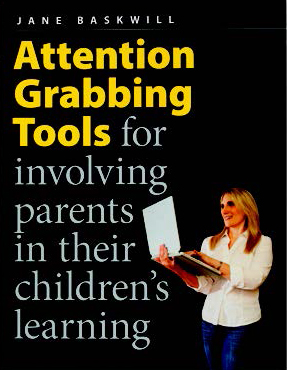
By Jane Baskwill
This timely book highlights research pointing to a strong link between parental engagement and their child’s success at school. Baskwill takes that research one step further by suggesting that frequent teacher-parent interaction should not be optional but an integral component of effective teaching.
Digital communication, including web pages, email, blogs, Facebook or Twitter, should be considered to establish reliable paths of communication. Inviting students to participate directly in this process can lead to even more engagement. The author cites one example of a Grade 5 teacher who designates a classroom tweeter, whose job is to post learning activities on Twitter. More traditional methods of communication between school and home, like newsletters, agendas, student portfolios, family nights and student-led conferences, are also acknowledged to be important ways in which teachers can interact with parents and caregivers.
Using a simple handwritten template, Baskwill suggests that teachers give their students time to draw pictures, write captions or describe briefly what they are learning each week so that parents get enough information to ensure that the “what did you do in school today” question will get more than the usual “nothing” response. Given its importance to learning, establishing regular two-way communication between school and home should be a priority for educators.
Michael Bellrose, OCT, is the principal at Algonquin Road PS in Sudbury.
Attention Grabbing Tools for involving parents in their children’s learning, Pembroke Publishers, Markham, 2013, softcover, ISBN 978-1-55138-283-8, 112 pages, $24.95, pembrokepublishers.com
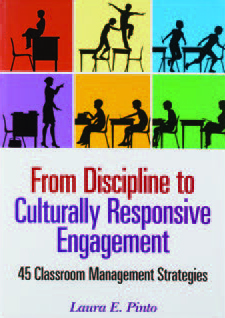
By Laura E. Pinto
This award-winning researcher and educator presents a unique book designed to guide educators through classroom management with one key difference — a highlighted approach to diversity and cultural responsiveness.
With a clear focus on democracy in education, she suggests 45 strategies any educator can use to manage a classroom that is ethnically inclusive and sensitive to pluralism. From Discipline to Culturally Responsive Engagement provides not only a rationale and critical reflection on cultural responsiveness, but also the nuts and bolts of how to implement strategies to promote inclusiveness in the classroom. The text clearly illustrates the importance of culturally sensitive teaching practices to bridge the gaps between a student’s culture at home and that of classrooms and schools. She challenges educators to reflect on the biases inherent in their own backgrounds, as well as to use the wealth of empirical data available to assess their classroom management strategies in light of cultural responsiveness. In the process, teachers are encouraged to broaden instructional practices that can have an impact on all aspects of classroom life.
Irma Berardi, OCT, is currently teaching Grade 5/6 at the Canadian International School in Kunshan, China.
From Discipline to Culturally Responsive Engagement: 45 Classroom Management Strategies, Corwin (a Sage company), 2013, Thousand Oaks, CA, ISBN 978-1- 4522-8521-4, 206 pages, US$34.95, corwinpress.com
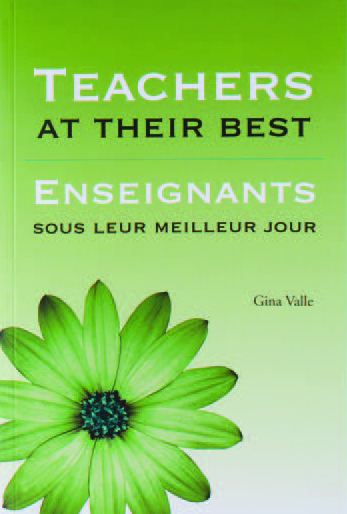
By Gina Valle
This simple book profiles eight teachers who teach really well within our culturally diverse schools. The first half of the book is in English, followed by a French version of the same text — graphically illustrating our official Canadian diversity. The teachers are quoted liberally to illustrate various themes. The author then analyzes what they have to say to illuminate why these teachers are so effective. The emphasis is on being open to what students bring to the classroom and to responding positively to their cultural identities without seeing them necessarily as the representatives of their ethnic heritage.
Valle shows educators exactly what these teachers do to act as intercultural brokers both within and beyond their classroom walls. Inside their classrooms, she shows them developing empathy among their students and removing obstacles to success. And inside their staff rooms, she observes them sharing information about how to create a culturally responsive school environment and enhance communication between schools and the home. In the last two sections, Valle examines the changing roles of educators and elucidates how these eight exemplary teachers have become responsive to diversity so they can treat their students equally but not the same.
Marguerite Alfred, OCT, is a retired vice-principal with the Toronto DSB.
Teachers at Their Best, Fourfront Editions (a division of Quattro Books), Toronto, 2012, softcover, ISBN 978-1-927443-08-8, 229 pages, $24.95, quattrobooks.ca
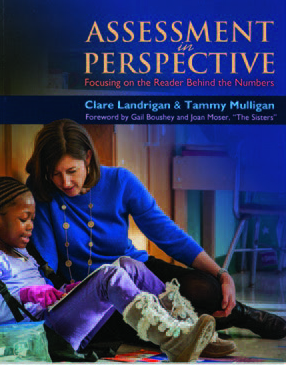
By Clare Landrigan and Tammy Mulligan
With careful referencing to some of the top names in the field and with practical examples, the authors confirm their belief that assessment cannot be separated from instruction. Six compact chapters follow a consistent format with explicit descriptions of why and how to apply assessment strategies.
In the first chapter, we are reminded that assessments help us understand how each student learns. The next chapter shows that daily student observations, as formative and informal assessments, are still among the best ways to inform our choices of teaching strategies. Another chapter provides clear and concise descriptions of the available literacy assessments, their purposes and applicable methodologies. Charts and tables complement the text to make the information readily accessible. An entire chapter is devoted to the importance of triangulating data: using different types of assessments at multiple intervals and comparing them side by side in order to identify patterns and/ or inconsistencies in students’ learning. Finally, the last chapter illustrates how the student can also become a source of information when viewing the collected data, responding to it with the teacher, and setting new learning goals for him/herself. This key metacognitive piece provides both motivation and meaning to students about their learning progress.
This is, without a doubt, one of the most practical texts currently available to empower teachers with strengthened skills and the confidence to effectively use assessments to increase students’ literacy success.
Christine Johnson, OCT, is a recently retired elementary school principal from the Ottawa-Carleton DSB.
Assessment in Perspective: Focusing on the Reader Behind the Numbers, Stenhouse Publishers, Portland, ME, 2013, softcover, ISBN 978-1- 57110-964-4, 140 pages, $29.95, stenhouse.com
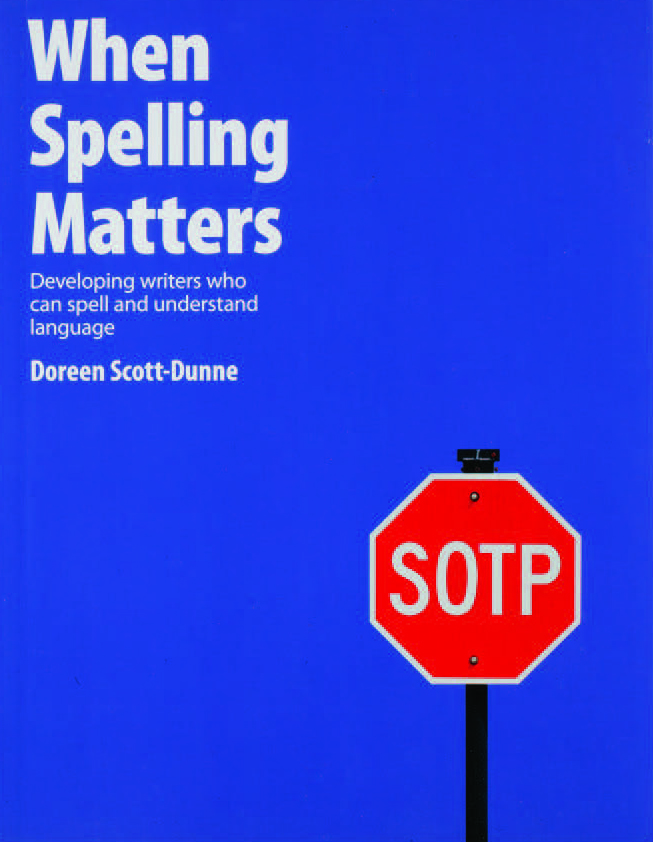
By Doreen Scott-Dunne
When does spelling matter? Drawing a direct line between correct spelling and the impression a person creates as a writer, the author suggests that all spelling meant for public consumption matters.
Learning to spell correctly goes well beyond rote memorization. The key is to learn to problem-solve the spelling of words by figuring out their origins and structures and perceiving how they fit into patterns. This understanding reflects that spelling is not a low-level activity, but a high-level cognitive skill. The author suggests that educators need to help students develop a love of words to make students into wordsmiths with a deeper understanding of what words are.
This resource provides much needed guidance to K–6 teachers to dispense with the mundane weekly lists of words that are given to students to memorize and forget moments after the dreaded Friday dictation. In its stead, it recommends implementing a process of word discovery. The author provides explicit lessons and lists of words and patterns that weave word appreciation across the curriculum. Scott-Dunne offers ideas for rhyming, authentic word walls, shared reading experiences, word quests, word inquiries and word investigation, making learning about words an interactive process for both teacher and student. She provides student work samples within the text, along with clever developmental continuums.
Sarah Lynn Frost Hunter, OCT, teaches Grade 3 at Kindree PS in the Peel DSB.
When Spelling Matters: Developing writers who can spell and understand language, Pembroke Publishers, Markham, 2012, softcover, ISBN 978-1-55138-277-7, 136 pages, $24.95, pembrokepublishers.com
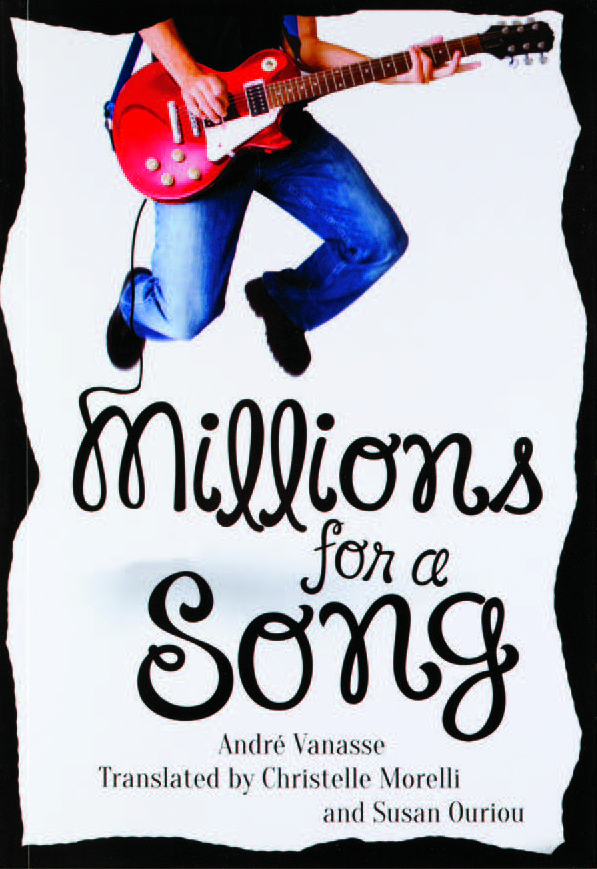
By André Vanasse, Translation Christelle Morelli and Susan Ouriou
This 1988 Governor General’s shortlisted young adult novel is still a gripping story and a pragmatic introduction into how the law can affect young people in this new translation. Narrator and songwriter Alex and his friends have a high school band that is wildly popular with the teens in their Quebec town. They work hard on their songs — writing and rewriting them line by line. It pays off when one of their songs goes viral. With the band’s rising popularity, Tom Paradis approaches them to be their manager. The band agrees hoping to secure more gigs. Paradis then registers all the band’s songs in the copyright office. But instead of using the names of the band members, he uses his own. The band first discovers they have been duped when they hear U2 sing one of their songs onstage, giving the credit and $10,000 to Paradis.
When the group gets legal representation, readers are walked through the process of how songs can be legally copyrighted. The lawyer shows the band the proper method for selling songs: how to register the lyrics and music with Consumer and Corporate Affairs; how to prove ownership; and how songs are sold and make money.
The novel essentially educates students in how to operate their own songwriting business. It would be a wonderful introduction to a business class or secondary law and ethics class. Students could even practise registering their own material with Industry Canada.
Kara Smith, OCT, is a writer, curriculum creator and associate professor at the Faculty of Education at the University of Windsor.
Millions for a Song, Red Deer Press, an imprint of Fitzhenry & Whiteside, Markham, 2013, softcover, ISBN 978-0-88995-489-2, 118 pages, $9.95, fitzhenry.ca

By Gordon Korman
Student engagement is a critical element of student success. Ungifted’s Donovan Curtis is not engaged and he is definitely not a student success. He pulls pranks to get attention and gain acceptance from his middle school peers. When one of his stunts goes awry, an administrative error finds him enrolled in a gifted program at an elite academy instead of a behaviour program at his home school. Donovan sees this as a chance for a fresh start and a way out of having to own up to the consequences of his actions. But can he mask his true identity and fit in with gifted students?
While several storylines involving Donovan’s family and friends help propel the tale, what is unique about this book is that each chapter is presented from a different character’s point of view. Written by bestselling author Gordon Korman, Ungifted relies heavily on stereotypical characters, but challenges the reader to see that behind the test scores, multiple intelligences, and first impressions, are individuals at risk of not discovering their true selves until the self-proclaimed ungifted Donovan pushes each out of their comfort zones and forces them to face the unknown. This is when real-life learning takes place.
Ungifted has read-aloud appeal and the themes of belonging and acceptance would make great classroom conversation starters. Because each chapter is as unique and individual as the character telling it, the book is ideal for modelling the writing voice.
Anne Marie Landon, OCT, is a Grade 1/2/3/4 teacher at George Vanier Catholic School in Combermere in the Renfrew County Catholic DSB.
Ungifted, Scholastic Canada Ltd., Toronto, 2012, hardcover, ISBN 978-1-4431-1920-7, 280 pages, $19.99, scholastic.ca
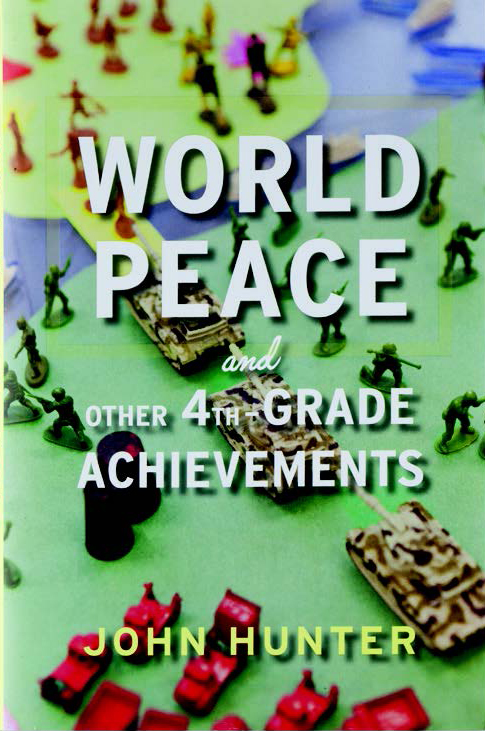
By John Hunter
Environmental degradation, climate change, ethnocultural conflicts, terrorism, war and global peace are hardly subjects that educators would expect students to address in elementary school. Yet these are the topics of discussion for John Hunter’s students as they play something he calls the World Peace Game.
For more than 35 years, Hunter, a celebrated teacher and speaker, has encouraged his students to solve the problems of the world by assigning roles to act out on an ersatz geopolitical stage. A prime minister is appointed for each nation who in turn selects a cabinet, a secretary of state, minister of defence and chief financial officer. Although the game is played with imaginary countries, navigating it requires a great deal of real-life statesmanship and knowledge.
Supported by rules, structure and teacher instruction, students are expected to use their expanding understanding of economics, politics and the environment to come up with creative solutions to the problems they encounter. After being given their top-secret dossiers, including a 13-page crisis document explaining a series of interlocking problems, the children engage in intricate negotiations to quell the potential chaos that is unleashed by the crisis. It’s as close to recreating real-life global politics at a Grade 4 or 5 level as is possible. Within the context of the game, failure is not only expected, it is actively encouraged, particularly when one player endeavours to act alone to “save” the world.
Drawing inspiration from historical heavyweights like Nelson Mandela, Martin Luther King and the great Chinese general/philosopher, Sun Tzu, Hunter’s students move from frustration to wisdom as they grapple with their own biases, fears and foibles to arrive at collaborative solutions that might work for everyone.
Michael Bellrose, OCT, is the principal at Algonquin Road PS in Sudbury.
World Peace and Other 4th-Grade Achievements, Eamon Dolan/Houghton Mifflin Harcourt, Boston, 2013, hardcover, ISBN 978-0- 547-90559-4, 256 pages, $29.99, distributed by Thomas Allen & Son Ltd., thomasallen.ca